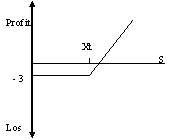A Note On Investment Strategies Involving Options



 <<Previous
INVESTMENT STRATEGIES INVOLVING OPTIONS Contd..
Call OptionsLet us understand the basics of call
option with the help of the following example:
Example:
A buys a European call option on a share of Philips at a premium of Rs. 3
per share on October 01, 2002. The strike price is Rs.65 and the contract
matures on December 31, 2002. The payoff table (Refer Table 2) shows the
payoffs for the investor on the basis of the different spot prices at any
given time. It is also clear from the graph that in the worst possible case,
A would only lose a maximum of Rs.3 per share, which has been paid as an
option premium. However, the upside to it is that he has an unlimited profit
opportunity.
On the contrary, the seller of the call option has a payoff chart,
completely reverse to that of the call options buyer. In this case, the
maximum profit a seller gains will be Rs.3 per share, while the losses
suffered would be unlimited.
Table 2: Payoff from Buying Call Option (Rs.)




| S |
Xt |
C |
Payoff |
Net Profit |
| 62 |
65 |
3 |
0 |
-3 |
| 63 |
65 |
3 |
0 |
-3 |
| 64 |
65 |
3 |
0 |
-3 |
| 65 |
65 |
3 |
0 |
-3 |
| 66 |
65 |
3 |
1 |
-2 |
| 67 |
65 |
3 |
2 |
-1 |
| 68 |
65 |
3 |
3 |
0 |
| 69 |
65 |
3 |
4 |
1 |
| 70 |
65 |
3 |
5 |
2 |
| 71 |
65 |
3 |
6 |
3 |

A European call option gives the following payoff to the
investor: max (S – Xt, 0).
The writer of a call option gets a payoff: min (Xt – S, 0).
Where,
S – Stock Price at time‘t'
Xt – Exercise Price at time‘t'
C – European Call Option Premium
Payoff – Max (S - Xt, 0)
Net Profit – Payoff minus 'C'
In the above example, we can infer that the buyer of the call option would
exercise his option only when he makes profit. If the spot price is lower
than the strike price, it would be profitable for A to buy the share in the
open market and forgo the premium paid.
Investors buy call options when they feel that the stock market will rise
significantly in the short term. However, if a shareholder feels that
his/her shares are not expected to rise in the short-term, he can earn a
premium by selling a call option on that share. The payoff diagram will be
completely opposite to that of an investor when he/she is long on call.
More...
TABLE 3: PAYOFF FROM SELLING A CALL OPTION (RS.)
TABLE 4: PAYOFF FROM BUYING OF PUT OPTION (RS.)
TABLE 5: PAYOFF FROM SELLING A PUT OPTION
TABLE 6: PAYOFF FROM BULL SPREAD USING CALLS
TABLE 7: PAYOFF FROM BEAR SPREAD USING CALLS
TABLE 8: PAYOFF USING BUTTERFLY SPREAD
TABLE 9: PAYOFF USING CONDOR SPREAD
TABLE 10: PAYOFF FROM LONG STRADDLE
TABLE 11: PAYOFF FROM LONG STRANGLE
TABLE 12: PAYOFF USING STRIPS
TABLE 13: PAYOFF USING STRAP
CONCLUSION
EXHIBIT I
ADDITIONAL READING & REFERENCES
2010, ICMR (IBS Center for Management Research).All rights reserved. No part of this publication may be
reproduced, stored in a retrieval system, used in a spreadsheet, or transmitted
in any form or by any means - electronic or mechanical, without permission.
To order copies, call +91- 8417- 236667 or write to ICMR,
Survey No. 156/157, Dontanapalli Village, Shankerpalli Mandal,
Ranga Reddy District,
Hyderabad-501504.
Andhra Pradesh, INDIA.
Mob: +91- 9640901313, Ph: +91- 8417- 236667,
Fax: +91- 8417- 236668
E-mail: info@icmrindia.org
Website: www.icmrindia.org
|